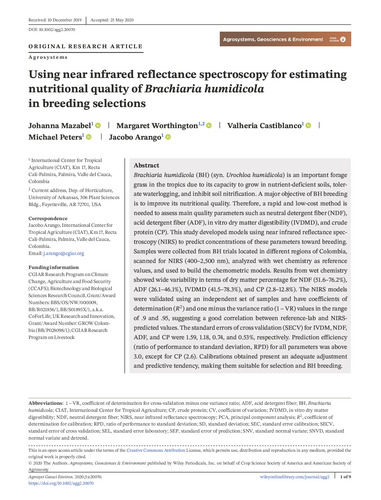Using near infrared reflectance spectroscopy for estimating nutritional quality of Brachiaria humidicola in breeding selections
Brachiaria humidicola (BH) (syn. Urochloa humidicola ) is an important forage grass in the tropics due to its capacity to grow in nutrient‐deficient soils, tolerate waterlogging, and inhibit soil nitrification. A major objective of BH breeding is to improve its nutritional quality. Therefore, a rapid and low‐cost method is needed to assess main quality parameters such as neutral detergent fiber (NDF), acid detergent fiber (ADF), in vitro dry matter digestibility (IVDMD), and crude protein (CP). This study developed models using near infrared reflectance spectroscopy (NIRS) to predict concentrations of these parameters toward breeding. Samples were collected from BH trials located in different regions of Colombia, scanned for NIRS (400–2,500 nm), analyzed with wet chemistry as reference values, and used to build the chemometric models. Results from wet chemistry showed wide variability in terms of dry matter percentage for NDF (51.6–76.2%), ADF (26.1–46.1%), IVDMD (41.5–78.3%), and CP (2.8–12.8%). The NIRS models were validated using an independent set of samples and have coefficients of determination (R 2) and one minus the variance ratio (1 – VR) values in the range of .9 and .95, suggesting a good correlation between reference‐lab and NIRS‐predicted values. The standard errors of cross validation (SECV) for IVDM, NDF, ADF, and CP were 1.59, 1.18, 0.74, and 0.53%, respectively. Prediction efficiency (ratio of performance to standard deviation, RPD) for all parameters was above 3.0, except for CP (2.6). Calibrations obtained present an adequate adjustment and predictive tendency, making them suitable for selection and BH breeding.

